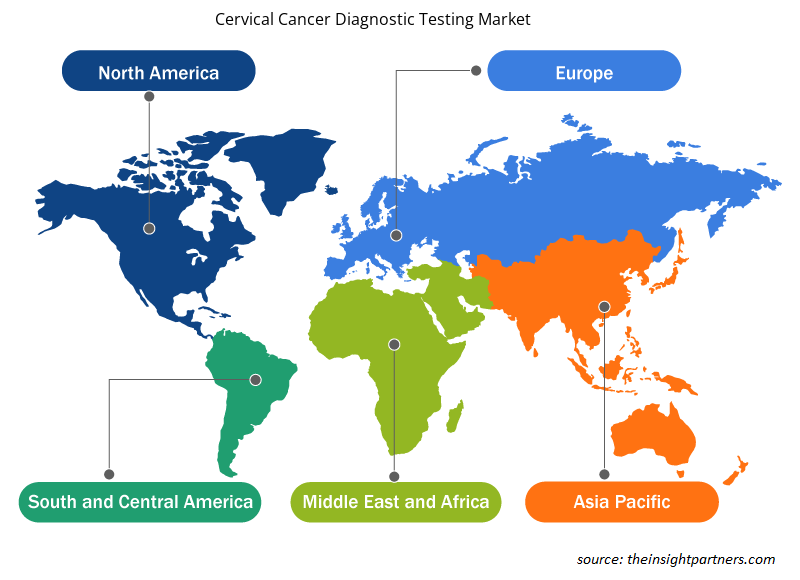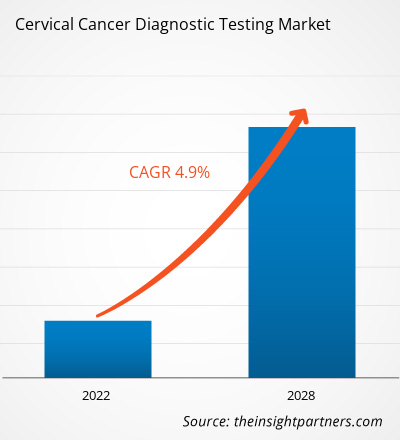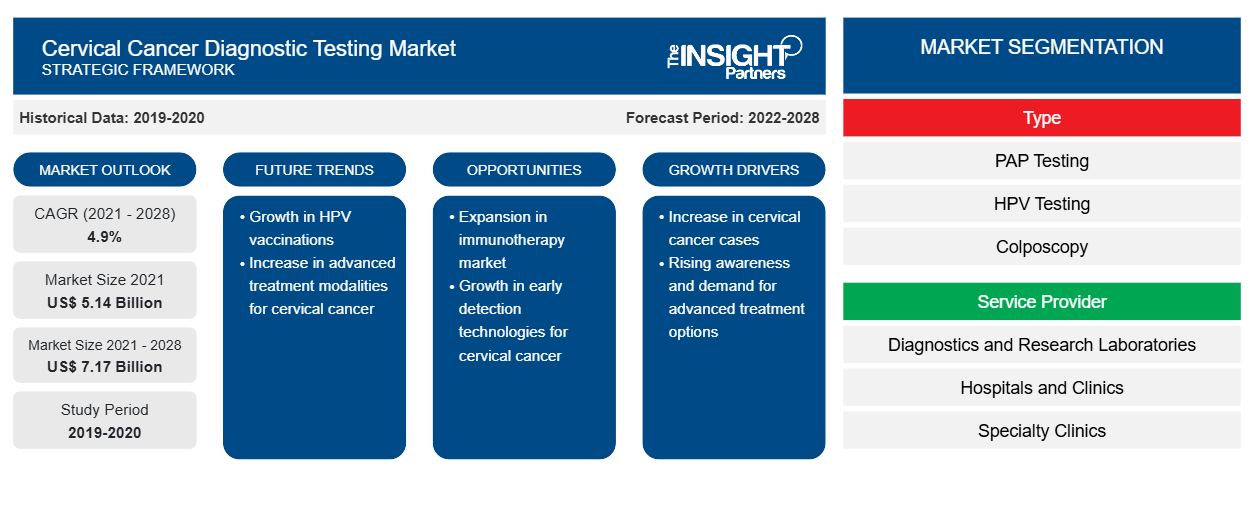Der Markt für Diagnosetests für Gebärmutterhalskrebs soll von 5.141,25 Millionen US-Dollar im Jahr 2021 auf 7.165,92 Millionen US-Dollar im Jahr 2028 anwachsen; von 2021 bis 2028 dürfte er voraussichtlich mit einer durchschnittlichen jährlichen Wachstumsrate von 4,9 % wachsen.
Gebärmutterhalskrebs hat eine hohe Sterblichkeitsrate (fast 50 %), die durch Früherkennung und Prävention gesenkt werden kann. Präkanzeröse Veränderungen bieten Möglichkeiten zur Prävention und Behandlung, da der Krankheitsverlauf oft verzögert ist. Aufgrund mangelnden Bewusstseins oder mangelnden Zugangs zu Diagnosediensten werden viele Fälle jedoch erst in späteren Stadien des Krankheitsverlaufs erkannt. Humanes Papillomavirus (HPV) ist eine Hauptursache für Gebärmutterhalskrebs und wird typischerweise durch sexuellen Kontakt übertragen. Es gibt über 100 HPV-Stämme, von denen 13 ein hohes oder krebserregendes Risiko darstellen. Das aktive Gen – E6 oder E7 – bestimmt, ob ein HPV-Stamm ein hohes oder niedriges Risiko darstellt. E6 bindet an p53 und verursacht proteolytische Zerstörung. E7 hingegen bindet an Retinoblastom; die Bindung verdrängt zuvor gebundene Transkriptionsfaktoren, was dazu führt, dass der Zellzyklus gestoppt und die Apoptoseregulierung gehemmt wird. Der HPV-Test erkennt humanes Papillomavirus in Gebärmutterhalszellen. Andere Screening-Ansätze, die in ressourcenarmen Gebieten von Entwicklungsländern eingesetzt werden, sind HPV-DNA-Tests und visuelle Untersuchungen. Regelmäßige Gebärmutterhalskrebs-Screenings helfen bei der Früherkennung von Gebärmutterhalskrebs und senken die Sterblichkeitsrate der Krankheit. Alle drei Jahre wird allen Frauen zwischen 21 und 65 Jahren empfohlen, einen Pap-Test durchführen zu lassen, und Frauen zwischen 30 und 65 Jahren wird empfohlen, sowohl einen Pap-Test als auch einen HPV-Test durchführen zu lassen. In Bezug auf den Umsatz dominierte diese Art den Markt für Gebärmutterhalskrebs-Screenings im Jahr 2021, und es wird erwartet, dass diese Dominanz im Prognosezeitraum anhält.
Passen Sie diesen Bericht Ihren Anforderungen an
Sie erhalten kostenlos individuelle Anpassungen an jedem Bericht, einschließlich Teilen dieses Berichts oder einer Analyse auf Länderebene, eines Excel-Datenpakets sowie tolle Angebote und Rabatte für Start-ups und Universitäten.
- Holen Sie sich die wichtigsten Markttrends aus diesem Bericht.Dieses KOSTENLOSE Beispiel umfasst eine Datenanalyse von Markttrends bis hin zu Schätzungen und Prognosen.
Markteinblicke:
Zunehmende Krebsprävalenz treibt Wachstum des Marktes für Diagnosetests für Gebärmutterhalskrebs im Prognosezeitraum voran
Krebs hat sich weltweit zu einer der häufigsten Todesursachen entwickelt. Laut der Weltgesundheitsorganisation (WHO) war Krebs im Jahr 2019 in 183 Ländern die häufigste Todesursache bei Menschen unter 70 Jahren und in 123 Ländern weltweit die vierthäufigste Todesursache. Darüber hinaus gab es laut im März 2021 von der WHO veröffentlichten Daten im Jahr 2020 etwa 10 Millionen Todesfälle aufgrund verschiedener Krebsarten. Die weltweit steigende Zahl von Gebärmutterhalskrebserkrankungen bei Frauen treibt das Wachstum des Marktes für Diagnosetests für Gebärmutterhalskrebs voran . Laut WHO sterben jedes Jahr mehr als 270.000 Frauen an Gebärmutterhalskrebs. Aufgrund der späten Diagnose der Krankheit ist die Sterblichkeitsrate bei Gebärmutterhalskrebs in Ländern mit niedrigem Einkommen höher. Es wird erwartet, dass der Markt in den kommenden Jahren wachsen wird, da Diagnosetests für Gebärmutterhalskrebs zur Früherkennung der Krankheit zunehmend akzeptiert werden.
Die zunehmende Verbreitung von Krebs hat die Gesundheitssysteme weltweit belastet. Laut der Internationalen Agentur für Krebsforschung (IARC) wird die weltweite Belastung durch neue Krebsfälle bis 2040 auf etwa 27,5 Millionen ansteigen, und die Krankheit wird bis dahin wahrscheinlich etwa 163 Millionen Todesfälle verursachen. Faktoren wie Veränderungen des Lebensstils, Rauchen, verringerte körperliche Aktivität sowie unsichere gesundheitliche und klimatische Bedingungen werden in den kommenden Jahren zu einer noch größeren Krebsbelastung auf der Welt führen.
Typbasierte Erkenntnisse
Der Markt für Diagnosetests für Gebärmutterhalskrebs ist nach Typ in PAP-Tests, HPV-Tests , Kolposkopie, Gebärmutterhalsbiopsien, Zystoskopie und andere unterteilt. Im Jahr 2021 hatte das Segment der PAP-Tests den größten Marktanteil und wird voraussichtlich zwischen 2021 und 2028 die höchste durchschnittliche jährliche Wachstumsrate verzeichnen.
Einblicke auf Dienstanbieterbasis
Basierend auf dem Dienstleister ist der Markt in Forschung, Diagnostik- und Forschungslabore, Krankenhäuser und Kliniken, Fachkliniken und häusliche Pflegedienste segmentiert. Im Jahr 2021 hielt das Segment Diagnostik- und Forschungslabore den größten Marktanteil und wird voraussichtlich zwischen 2021 und 2028 die höchste CAGR auf dem Markt verzeichnen.
Unternehmen, die auf dem Markt für diagnostische Tests für Gebärmutterhalskrebs tätig sind, verfolgen verschiedene Strategien wie Produktinnovationen, um den sich entwickelnden Kundenanforderungen auf der ganzen Welt gerecht zu werden und ihren Markennamen auf dem Weltmarkt zu behaupten.
Markt für Diagnosetests für Gebärmutterhalskrebs – Segmentierung
Der Markt für Diagnosetests für Gebärmutterhalskrebs ist nach Typ und Dienstleister segmentiert. Nach Typ ist der Markt in PAP-Tests, HPV-Tests, Kolposkopie, Gebärmutterhalsbiopsien, Zystoskopie und andere unterteilt. Nach Dienstleister ist der Markt weiter in Diagnose- und Forschungslabore, Krankenhäuser und Kliniken, Fachkliniken und häusliche Pflegedienste segmentiert.
Geografisch ist der Markt für Diagnosetests für Gebärmutterhalskrebs in Nordamerika (USA, Kanada und Mexiko), Europa (Frankreich, Deutschland, Italien, Großbritannien, Spanien und Rest von Europa), Asien-Pazifik (Australien, China, Indien, Japan, Südkorea und Rest von Asien-Pazifik), Naher Osten und Afrika (Saudi-Arabien, Südafrika, Vereinigte Arabische Emirate und Rest von Afrika) sowie Süd- und Mittelamerika (Brasilien, Argentinien und Rest von Südafrika) segmentiert.
Regionale Einblicke in den Markt für Diagnosetests für Gebärmutterhalskrebs
Die regionalen Trends und Faktoren, die den Markt für Diagnosetests für Gebärmutterhalskrebs im Prognosezeitraum beeinflussen, wurden von den Analysten von Insight Partners ausführlich erläutert. In diesem Abschnitt werden auch die Marktsegmente und die Geografie für Diagnosetests für Gebärmutterhalskrebs in Nordamerika, Europa, im asiatisch-pazifischen Raum, im Nahen Osten und Afrika sowie in Süd- und Mittelamerika erörtert.

- Erhalten Sie regionale Daten zum Markt für Diagnosetests für Gebärmutterhalskrebs
Umfang des Marktberichts zu Diagnosetests für Gebärmutterhalskrebs
| Berichtsattribut | Details |
|---|---|
| Marktgröße im Jahr 2021 | 5,14 Milliarden US-Dollar |
| Marktgröße bis 2028 | 7,17 Milliarden US-Dollar |
| Globale CAGR (2021 - 2028) | 4,9 % |
| Historische Daten | 2019-2020 |
| Prognosezeitraum | 2022–2028 |
| Abgedeckte Segmente | Nach Typ
|
| Abgedeckte Regionen und Länder | Nordamerika
|
| Marktführer und wichtige Unternehmensprofile |
|
Dichte der Marktteilnehmer für Diagnosetests für Gebärmutterhalskrebs: Auswirkungen auf die Geschäftsdynamik verstehen
Der Markt für Diagnosetests für Gebärmutterhalskrebs wächst rasant. Dies wird durch die steigende Nachfrage der Endnutzer aufgrund von Faktoren wie sich entwickelnden Verbraucherpräferenzen, technologischen Fortschritten und einem größeren Bewusstsein für die Vorteile des Produkts vorangetrieben. Mit der steigenden Nachfrage erweitern Unternehmen ihr Angebot, entwickeln Innovationen, um die Bedürfnisse der Verbraucher zu erfüllen, und nutzen neue Trends, was das Marktwachstum weiter ankurbelt.
Die Marktteilnehmerdichte bezieht sich auf die Verteilung von Firmen oder Unternehmen, die in einem bestimmten Markt oder einer bestimmten Branche tätig sind. Sie gibt an, wie viele Wettbewerber (Marktteilnehmer) in einem bestimmten Marktraum im Verhältnis zu seiner Größe oder seinem gesamten Marktwert präsent sind.
Die wichtigsten Unternehmen auf dem Markt für Diagnosetests für Gebärmutterhalskrebs sind:
- F. HOFFMANN-LA ROCHE LTD.
- Abbott
- Quest Diagnostics GmbH
- QIAGEN
- Hologic, Inc.
Haftungsausschluss : Die oben aufgeführten Unternehmen sind nicht in einer bestimmten Reihenfolge aufgeführt.

- Überblick über die wichtigsten Akteure auf dem Markt für Diagnosetests für Gebärmutterhalskrebs
Firmenprofile
- F. Hoffmann-La Roche Ltd.
- Abbott
- Quest Diagnostics GmbH
- QIAGEN
- Hologic, Inc.
- DYSIS Medical Inc.
- Femasys Inc.
- Guided Therapeutics, Inc.
- Cooper Companies, Inc.
- BD
- Historische Analyse (2 Jahre), Basisjahr, Prognose (7 Jahre) mit CAGR
- PEST- und SWOT-Analyse
- Marktgröße Wert/Volumen – Global, Regional, Land
- Branchen- und Wettbewerbslandschaft
- Excel-Datensatz
Aktuelle Berichte
Verwandte Berichte
Erfahrungsberichte
Grund zum Kauf
- Fundierte Entscheidungsfindung
- Marktdynamik verstehen
- Wettbewerbsanalyse
- Kundeneinblicke
- Marktprognosen
- Risikominimierung
- Strategische Planung
- Investitionsbegründung
- Identifizierung neuer Märkte
- Verbesserung von Marketingstrategien
- Steigerung der Betriebseffizienz
- Anpassung an regulatorische Trends























 Kostenlose Probe anfordern für - Markt für Diagnosetests für Gebärmutterhalskrebs
Kostenlose Probe anfordern für - Markt für Diagnosetests für Gebärmutterhalskrebs